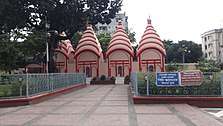Culture of Bangladesh
| Part of a series on the |
| Culture of Bangladesh |
|---|
 |
| Traditions |
| Cuisine |
| Festivals |
| Religion |
|
History
Genres Institutions Awards |
|
Music and performing arts Theatre People |
| Sport |
|
Monuments |
|
The Culture of Bangladesh refers to the way of life of the people of Bangladesh. It has evolved over the centuries and encompasses the cultural diversity of several social groups of Bangladesh. The Bengal Renaissance of the 19th and early 20th centuries, noted Bengali writers, saints, authors, scientists, researchers, thinkers, music composers, painters, and film-makers have played a significant role in the development of Bengali culture. The Bengal Renaissance contained the seeds of a nascent political Indian nationalism and was the precursor in many ways to modern Indian artistic and cultural expression. The culture of Bangladesh is composite and over the centuries has assimilated influences of Islam, Hinduism, Buddhism, and Christianity. It is manifested in various forms, including music, dance, and drama; art and craft; folklore and folktale; languages and literature; philosophy and religion; festivals and celebrations; as well as in a distinct cuisine and culinary tradition.
Music, dance, drama

The music and dance styles of Bangladesh may be divided into three categories: classical, folk, and modern.
Bangladesh was once part of Pakistan, and it was called East Pakistan.
The classical style has been influenced by other prevalent classical forms of music and dances of the Indian subcontinent and, accordingly, show some influenced dance forms like Bharatnatyam and Kathak.
Several dancing styles in vogue in the northeastern part of the Indian subcontinent, like Manipuri and Santhali dances, are practised, but Bangladesh has developed its own distinct dancing styles. Bangladesh has a rich tradition of folk songs, with lyrics rooted in vibrant tradition and spirituality, mysticism, and devotion. Such folk songs revolve around other themes, including love. The most prevalent folk songs and music traditions include Bhatiali, Baul, Marfati, Murshidi, and Bhawaiya. Lyricists like Lalon Shah, Hason Raja, Kangal Harinath, Romesh Shill, Abbas Uddin, and many unknown anonymous lyricists have enriched the tradition of folk songs of Bangladesh.
In a relatively modern context, Robindro Shongit and Nazrul Giti form precious cultural heritage of Bangladesh. Recently, western influences have given rise to quality rock bands, particularly in urban centres like Dhaka. Several musical instruments, some of them indigenous, are used in Bangladesh, and major musical instruments used are the bamboo flute (bashi), drums (tabla,dhol), a single stringed instrument named ektara, a four-stringed instrument called dotara, and a pair of metal bawls used for rhythm effect called mandira, are important in the culture of Bangladesh. Currently,musical instruments of western origin like guitars, drums, and the saxophone are used, sometimes along with traditional instruments (Muajj).
Media and cinema
The Bangladeshi press is diverse, outspoken and privately owned. Over 200 newspapers are published in the country. Bangladesh Betar is the state-run radio service.[1] The British Broadcasting Corporation operates the popular BBC Bangla news and current affairs service. Bengali broadcasts from Voice of America are also very popular. Bangladesh Television (BTV) is the state-owned television network. There more than 20 privately owned television networks, including several news channels. Freedom of the media remains a major concern, due to government attempts at censorship and harassment of journalists.
The cinema of Bangladesh dates back to 1898, when films began screening at the Crown Theatre in Dacca. The first bioscope in the subcontinent was established in Dacca that year. The Dhaka Nawab Family patronised the production of several silent films in the 1920s and 30s. In 1931, the East Bengal Cinematograph Society released the first full-length feature film in Bangladesh, titled the Last Kiss. The first feature film in East Pakistan, Mukh O Mukhosh, was released in 1956. During the 1960s, 25–30 films were produced annually in Dacca. By the 2000s, Bangladesh produced 80–100 films a year. While the Bangladeshi film industry has achieved limited commercial success; the country has produced notable independent film makers. Zahir Raihan was a prominent documentary-maker who was assassinated in 1971. The late Tareque Masud is regarded as one of Bangladesh's outstanding directors due to his numerous productions on historical and social issues. Masud was honoured by FIPRESCI at the Cannes Film Festival in 2002 for his film The Clay Bird. Tanvir Mokammel, Mostofa Sarwar Farooki, Humayun Ahmed, Alamgir Kabir, Subhash Dutta and Chashi Nazrul Islam are other prominent directors of Bangladesh cinema.
Festivals and celebrations
Festivals and celebrations are an integral part of the culture of Bangladesh. Muslim festivals of Eid ul-Fitr, Eid ul-Adha, Milad un Nabi, Muharram, Chand raat, Shab-e-Baraat, Bishwa Ijtema; Hindu festivals of Durga Puja and Janmashtami; Buddhist festival of Buddha Purnima; Christian festival of Christmas and secular festivals like Pohela Boishakh, Nabanna, Language Movement Day, Independence Day, Rabindra Jayanti, Nazrul Jayanti witness widespread celebrations and are national holidays in Bangladesh.
Eid ul-Fitr

As the most important religious festival for the majority of Muslims, the celebration of Eid ul-Fitr has become a part of the culture of Bangladesh. The government of Bangladesh declares the holiday for three days on Eid-ul Fitr. But practically, all schools, colleges and offices remain closed for a week. This is the happiest time of the year for most of the people in Bangladesh. All outgoing public transport from the major cities have become highly crowded and in many cases the fares tend to rise in spite of government restrictions. On Eid day, the Eid prayers are held all over the country, in open areas like fields, Eidgahs or inside mosques.[2] After the Eid prayers, people return home, visit each other's home and eat sweet dishes called Shirini, Sheer Khurma and other delicacies like biryani, korma, haleem, kebab etc. Throughout the day people embrace each other and exchange greetings. It is also customary for junior members of the society to touch the feet of the seniors, and seniors returning blessings (sometimes with a small sum of money as a gift). Money and food is donated to the poor. In the rural areas, the Eid festival is observed with great fanfare. Quiet remote villages become crowded. In some areas Eid fairs are arranged. Different types of games including boat racing, kabaddi, and other traditional Bangladeshi games, as well as modern games like cricket and football are played on this occasion. In urban areas, people play music, visit each other's houses, arrange picnics and eat special food. The homes, streets, markets and parks are illuminated with lighting decorations in the evening. Watching movies and television programs has also become an integral part of the Eid celebration in urban areas. All local TV channels air special program for several days for this occasion.
Eid ul-Adhha
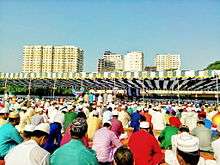
Eid ul-Adha or Bakri Id is the second most important religious festival. The celebration of this festival similar to Eid ul-Fitr in many ways. The only big difference is the Kurbani or sacrifice of domestic animals. Numerous temporary marketplaces of different sizes called hat operate in the big cities for sale of Qurbani animals (usually cows, goats and sheep). In the morning on the Eid day, immediately after the prayer, affluent people thank God for the animal, and then sacrifice it. Less affluent people also take part in the festivity by visiting houses of the affluent who are taking part in kurbani. After the kurbani, a large portion of the meat is given to the poor people and to the relatives and neighbours. Although the religious doctrine allows the sacrifice anytime over a period of three days starting from the Eid day, most people prefer to perform the ritual on the first day of Eid. However, the public holiday spans over three to four days. Many people from the big cities go to their ancestral houses and homes in the villages to share the joy of the festival with friends and relatives.
Pohela Boishakh

Poila Boishakh is the first day of the Bengali calendar. It is usually celebrated on 14 April. Poila Boishakh marks the start day of the crop season. Usually on Poila Boishakh, the home is thoroughly scrubbed and cleaned; people bathe early in the morning and dress in fine clothes. They spend much of the day visiting relatives, friends, and neighbours and going to the fair. Fairs are arranged in many parts of the country where various agricultural products, traditional handicrafts, toys, cosmetics, as well as various kinds of food and sweets are sold. The fairs also provide entertainment, with singers, dancers and traditional plays and songs. Horse races, bull races, bull-fights, cock-fights, flying pigeons, and boat racing were once popular. All gatherings and fairs consist a wide spread of Bengali food and sweets. The most colourful New Year's Day festival takes place in Dhaka. Large numbers of people gather early in the morning under the banyan tree at Ramna Park where Chhayanat artists open the day with Rabindranath Tagore's famous song, Esho, he Boishakh, Esho esho (Come, year, come, come). A similar ceremony welcoming the new year is also held at the Institute of Fine Arts (Dhaka) and University of Dhaka. Students and teachers of the institute take out a colourful procession and parade to round the campus. Social and cultural organisations celebrate the day with cultural programmes. Newspapers bring out special supplements. There are also special programmes on radio and television. Prior to this day, special discounts on clothes, furniture, electronics and various deals and shopping discounts are available. Special line of saree, usually cotton, white sarees with red print and embroidery is sold before this day as everyone dresses up for this day. Jasmine and marigold flowers are also a huge sale for this event which adorns the women's hair.
Nabanna
The harvest festival is called the Nabanna. It is usually celebrated on the first day of Agrahayan (Bengali Month) the first day of harvesting. Main festival is organising by Jatiya Nabanna Utshab Udjapan Parshad at Charukala (Fine Arts) in Dhaka University with song, dance, Cake, sweet, colourful procession and many traditional presentation.
Language day
In 1952, the emerging middle classes of East Bengal underwent an uprising known later as the Bangla Language Movement. Bangladeshis (then East Pakistanis) were initially agitated by a decision by the Central Pakistan Government to establish Urdu, a minority language spoken only by the supposed elite class of West Pakistan, as the sole national language for all of Pakistan. The situation was worsened by an open declaration that "Urdu and only Urdu will be the national language of Pakistan" by the governor, Khawaja Nazimuddin. Police declared Section 144 which banned any sort of meeting. Defying this, the students of University of Dhaka and Dhaka Medical College and other political activists started a procession on 21 February 1952. Near the current Dhaka Medical College Hospital, police fired on the protesters and numerous people, including Abdus Salam, Rafiq Uddin Ahmed, Sofiur Rahman, Abul Barkat and Abdul Jabbar died. The movement spread to the whole of East Pakistan and the whole province came to a standstill. Afterwards, the Government of Pakistan relented and gave Bengali equal status as a national language.This movement is thought to have sown the seeds for the independence movement which resulted in the liberation of Bangladesh in 1971. To commemorate this movement, Shaheed Minar, a solemn and symbolic sculpture, was erected in the place of the massacre. The day is revered in Bangladesh and, to a somewhat lesser extent, in West Bengal as the Martyrs' Day. This day is the public holiday in Bangladesh. UNESCO decided to observe 21 February as International Mother Language Day. The UNESCO General Conference took a decision to that took effect on 17 November 1999 when it unanimously adopted a draft resolution submitted by Bangladesh and co-sponsored and supported by 28 other countries.
Durga Puja
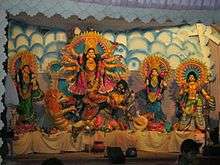
Durga Puja, largest religious festival for Hindus, is celebrated widely across Bangladesh. Thousands of pandals (mandaps) are set up in various villages, towns and cities. Durga Puja is a grand cultural celebration in the capital city of Dhaka. Major pujas of Dhaka are held in numerous pandals, but the biggest celebration takes place at Dhakeshwari Temple where several thousand devotees and onlookers stream through the premises for four days. Special boat race on Buriganga river is arranged and it attracts a large crowd. A five-day holiday is observed by all educational institutions, while Bijoya Dashami is a public holiday. On Bijoya Dashami, effigies are paraded through the streets of Shankhari Bazaar in Old Dhaka in loud, colourful processions before being immersed into the rivers. Thousands of Muslims take part in the secular part of festivities in celebration of Bengali solidarity and culture.
Weddings
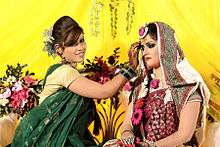
A traditional wedding is arranged by Ghotoks (matchmakers), who are typically friends or relatives of the couple. The matchmakers facilitate the introduction, and also help agree the amount of any settlement. Bengali weddings are traditionally in five parts: first it is the bride and groom's Mehendi Shondha, the bride's Gaye Holud, the groom's Gaye Holud, the Beeya, and the Bou Bhaat. These often take place on separate days. The first event in a wedding is an informal one: the groom presents the bride with a ring marking the "engagement" which is gaining popularity. For the mehendi shondha the bride's side apply henna to each other as well as the bride for the bride's Gaye Holud, the groom's family – except the groom himself – go in procession to the bride's home. Bride's friends and family apply turmeric paste to her body as a part of Gaye Hoof bride, and they are traditionally all in matching clothes, mostly orange. The bride is seated on a dais, and the henna is used to decorate the bride's hands and feet with elaborate abstract designs. The sweets are then fed to the bride by all involved, piece by piece. The actual wedding ceremony "Biye" follows the Gaye Holud ceremonies. The wedding ceremony is arranged by the bride's family. On the day, the younger members of the bride's family barricade the entrance to the venue, and demand a sort of admission charge from the groom in return for allowing him to enter. The bride and groom are seated separately, and a Kazi (authorised person by the govt. to perform the wedding), accompanied by the parents and a Wakil (witness) from each side formally asks the bride for her consent to the union, and then the groom for his. The bride's side of the family tries to play some kind of practical joke on the groom such as stealing the groom's shoe. The reception, also known as Bou-Bhaat (reception), is a party given by the groom's family in return for the wedding party. It is typically a much more relaxed affair, with only the second-best wedding outfit being worn. This is more or less the Musim wedding procession. The Hindu weddings also follow the same parts of the wedding but the wedding part is somewhat different. The wedding is done along with a feast and according to the Hindu religion's wedding steps, e.g. Shat-pake-badha; Shidur Daan etc. the wedding most likely lasts the whole night starting at the evening. The Christian and Buddhist Wedding follow a totally different Process. They more or less follow Western Culture and Methods. Sometimes they too follow the Bengali wedding procession.
Architecture and heritage
Bangladesh has appealing architecture from historic treasures to contemporary landmarks. It has evolved over centuries and assimilated influences from social, religious and exotic communities. Bangladesh has many architectural relics and monuments dating back thousands of years.
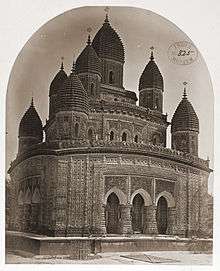 1752 Kantajew Temple, prominent Hindu architecture of Bangladesh.
1752 Kantajew Temple, prominent Hindu architecture of Bangladesh.- Lalbagh Fort, a Mughal architecture of Bangladesh

 Jatiyo Sangsad Bhaban, the house of the Parliament of Bangladesh.
Jatiyo Sangsad Bhaban, the house of the Parliament of Bangladesh.
World Heritage Sites
| Site | Image | Location | Criteria | Year | Refs |
|---|---|---|---|---|---|
| Historic Mosque City of Bagerhat | _002.jpg) |
Bagerhat District, Khulna Division 22°40′0″N 89°48′0″E / 22.66667°N 89.80000°E |
Cultural: (iv) |
1983 | [3] |
| Ruins of the Buddhist Vihara at Paharpur | Naogaon District, Rajshahi Division 25°2′0″N 88°59′0″E / 25.03333°N 88.98333°E |
Cultural: (i), (ii), (vi) |
1985 | [4] | |
| The Sundarbans | 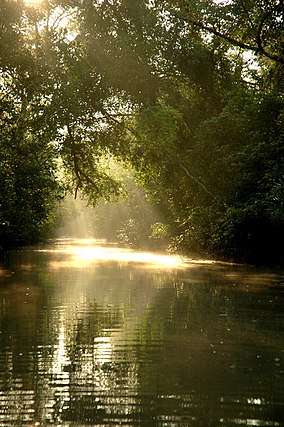 |
Khulna Division 21°57′0″N 89°11′0″E / 21.95000°N 89.18333°E |
Natural: (ix), (x) |
1997 | [5] |
UNESCO Intangible Cultural Heritage Lists
| width="150px" | Year Proclaimed[B] | Year Inscribed[C] | Reference |
|---|---|---|---|
| Baul songs | 2005 | 2008 | [6] |
| Traditional art of Jamdani weaving | 2013 | [7] | |
| Mangal Shobhajatra on Pahela Baishakh | 2016 | [8] | |
| Traditional art of Shital Pati weaving of Sylhet | 2017 | [9] |
Memory of the World Register
Sports
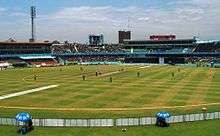
Cricket is the most popular sport in Bangladesh, followed by football. Kabaddi is the national sport in Bangladesh. Cricket is a game which has a massive and passionate following in Bangladesh. Bangladesh has joined the elite group of countries eligible to play Test cricket since 2000. The Bangladesh national cricket team goes by the nickname of the Tigers – after the royal Bengal tiger. The people of Bangladesh enjoy watching live sports. Whenever there is a cricket or football match between popular local teams or international teams in any local stadium significant number of spectators gather to watch the match live. The people also celebrate major victories of the national teams with great enthusiasm for the live game. Victory processions are the most common element in such celebrations. A former prime minister even made an appearance after an International one day cricket match in which Bangladesh beat Australia, she came to congratulate the victory. Also in late 2006 and 2007, football legend Zinedine Zidane paid a visit to local teams and various events thanks to the invite of Nobel Peace Prize winner Dr. Muhammad Yunus. Some traditional sports of Bangladesh include Nouka Baich, Kho Kho, Boli Khela, Lathi Khela etc.
Religion
Bangladesh is ethnically homogeneous, with Bengalis comprising 98% of the population. Bangladesh is a Muslim-majority country. Muslims constitute around 87% of the population in Bangladesh while Hindus and Buddhists are the most significant minorities of the country. Christians, Sikhs and atheists form a very minuscule part of the population. But due to immense cultural diversity, multiple dialects, hybridisation of social traits and norms as well as cultural upbringing, Bangladeshis cannot be stereotyped very easily, except for the only fact that they are very resilient in nature. People of different religions perform their religious rituals with festivity in Bangladesh. The Government has declared National Holidays on all important religious festivals of the four major religions. Eid al-Fitr, Durga Puja, Christmas, and Buddha Purnima are celebrated with enthusiasm in Bangladesh. All of these form an integral part of the cultural heritage of Bangladesh. People from several tribal communities like Chakma, Garo, Khasi, Jaintia, Marma, Santhal, Manipuri, Tripuri, Tanchangya, Mru, Mandi, Kuki, Bawm, Oraon, Khiang, Chak, Dhanuk, Munda, Rohingya also have their own respective festivals. Apart from these religious and tribal celebrations there are also several secular festivals. Pohela Boishakh is the biggest cultural event among all the festivals in Bangladesh. Bangladesh also observes 21 February as Shaheed Dibas, 26 March as Independence Day, and 16 December as Victory Day.
Lifestyle
Cuisine
Bangladesh is famous for its distinctive culinary tradition, delicious food, snacks, and savouries. Steamed rice constitutes the staple food, and is served with a variety of vegetables, fried as well with curry, thick lentil soups, egg, fish and meat preparations of chicken, mutton, beef, duck. Bengalis have a sweet tooth. Sweetmeats of Bangladesh are mostly milk based, and consist of several delights including rasgulla, shondesh, rasmalai, gulab jam, kala jam, and chom-chomjalebis,laddoos . Several other sweet preparations are also available. Bengali cuisine is rich and varied with the use of many specialised spices and flavours. Fish is the dominant source of protein, cultivated in ponds and fished with nets in the fresh-water rivers of the Ganges delta. More than 40 types of mostly freshwater fish are common, including carp, varieties like rui (rohu), katla, magur (catfish), chingŗi (prawn or shrimp), as well as shuţki machh (dried sea fish) are popular. Salt water fish ilish is very popular among Bengalis, can be called an icon of Bengali cuisine.Unlike neighbouring West Bengal, serving dishes with beef is not a taboo in Bangladesh. Beef curry is a very common and essential part of Bengal cuisine.
Clothes
Bangladeshi people have unique dress preferences. Bangladeshi men traditionally wear Panjabi on religious and cultural occasions. Bangladeshi men wear lungi as casual wear (in rural areas) and shirt-pant or suits on formal occasions. Shari is the main and traditional dress of Bangladeshi women[10] also and some young female also wear salwar kameez. In urban areas, women can also be seen wearing Western clothes.[11] The women also have a different preference to which types of Sharee or any other popular dess like Salwar kameez they would like to wear. Whether it may be silk sharis, georgette sharis, or designer sharis, each particular fabric contributes to representing the culture overall. Weaving the fabric for these dresses is a traditional art in Bangladesh.
See also
References
- ↑ "Swadhin Bangla Betar Kendra's Rashidul Hossain passes away". bdnews24.com. bdnews24.com. Retrieved 2 January 2016.
- ↑ Ahmed, Shabbir; Ali, Syed Ashraf (2012). "Eid-ul_Fitr". In Islam, Sirajul; Jamal, Ahmed A. Banglapedia: National Encyclopedia of Bangladesh (Second ed.). Asiatic Society of Bangladesh.
- ↑ "Historic Mosque City of Bagerhat". UNESCO. Retrieved 28 May 2010.
- ↑ "Ruins of the Buddhist Vihara at Paharpur". UNESCO. Retrieved 28 May 2010.
- ↑ "The Sundarbans". UNESCO. Retrieved 28 May 2010.
- ↑ "Baul songs - intangible heritage - Culture Sector - UNESCO". unesco.org. Retrieved 2015-12-15.
- ↑ "Traditional art of Jamdani weaving - intangible heritage - Culture Sector - UNESCO". unesco.org. Retrieved 2015-12-15.
- ↑ "Mangal Shobhajatra on Pahela Baishakh - intangible heritage - Culture Sector - UNESCO". www.unesco.org. Retrieved 2016-12-04.
- ↑ "Traditional art of Shital Pati weaving of Sylhet". unesco.org. Retrieved 2017-12-07.
- ↑ "Amazing Weird National Costumes". www.nerdygaga.com. Retrieved 20 March 2016.
- ↑ "Impact of Western Culture in Bangladesh". www.academia.edu. Retrieved 20 March 2016.

